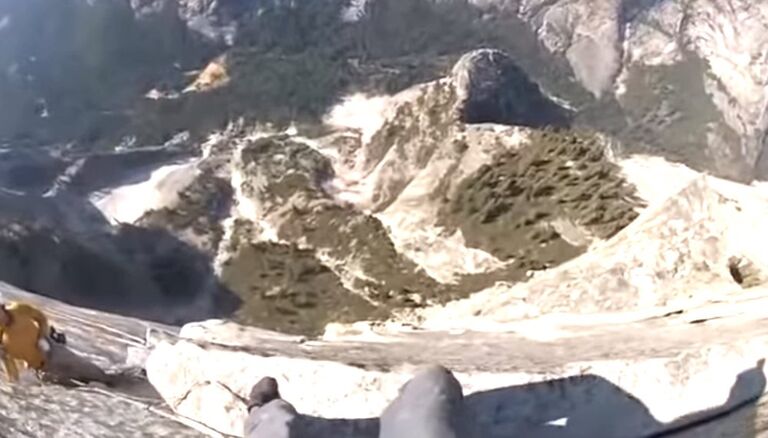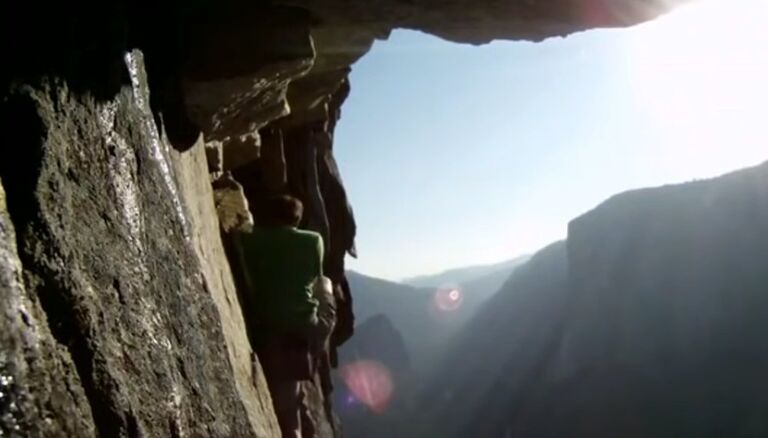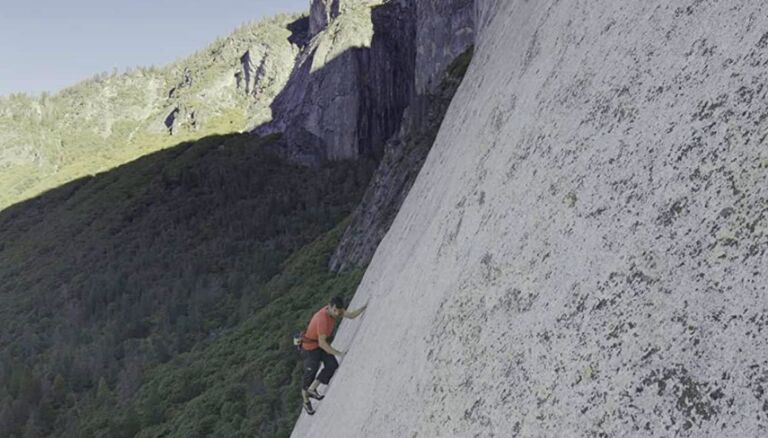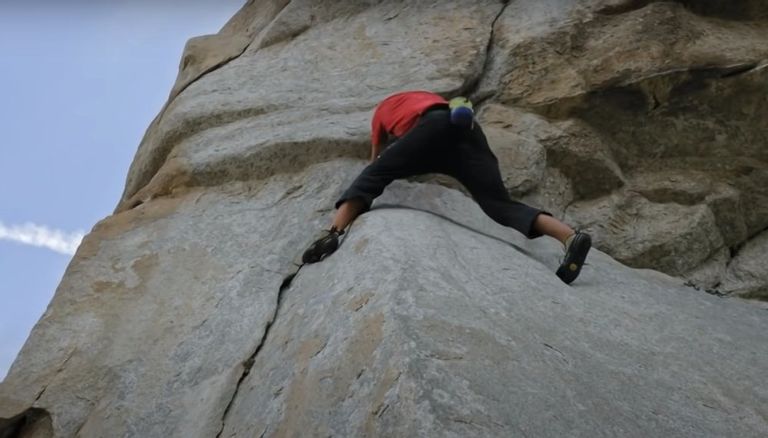Fearless Man Climbs Mountains Effortlessly – Brain Scan Explains How
You might like mountain climbing or have tried it once or twice. Do you know how climbers gear up with ropes, bungee cords, and special protective gear? Meet Alex Honnold, who climbs with no gear at all.
Alex uses only his hands to climb, regardless of the weather conditions. Well, there’s a reason Alex can do this, and scientists found out when they scanned his brain.
What’s His Brain Got to Do With It?
Scientists were anxious to discover what enables a person to undertake such a dangerous endeavor. It seems that some people enjoy these kinds of risks and even have a need for risk-taking. Scientists want to know why.

Source: Zinkevych/Getty Images
The brain scan took place at the Center for Biomedical Imaging in Charleston, South Carolina. The Center has some incredible equipment that takes unique pictures of brain activity. It was here that scientists wanted Alex to have a specialized brain scan.
Some Info About fMRI Scanners
You may never have heard of a functional magnetic resonance imaging machine, or fMRI, although they’ve been around since the early 1990s. The introduction of fMRI at that time revolutionized scientists’ understanding of how the brain works.

Source: IMDb
This piece of equipment shows changes in how the blood flows through your brain. You see, the brain absorbs oxygen while it’s active, and the colors of blood flow show up on the screen. This way, the technical staff can see exactly when the brain is active and where the blood is moving.
The Brain is an Amazing Organ
Dr. Jane Joseph of the Medical University of South Carolina was interested in the field of blood flow through the brain, and her institution was home to this new medical equipment. She wanted to use the fMIR to track Honnold’s brain activity.

Source: Alex Honnold/Facebook
Joseph believed that the way blood flows in the brains of some humans might have ties to a characteristic known as “sensation seeking.” That term can mean anything from addiction to certain behaviors to engaging in dangerous activities. Honnold was a perfect person to study in order to test that theory.
Are You Afraid?
This gets even more fascinating. There happens to be a section of the brain that identifies fear, called the amygdala. While undergoing an fMRI exam, if that part of the brain “lights up,” it means that the person feels fear.

Source: Mark Kostich/Getty Images
So Dr. Joseph wanted to look at the area of Honnold’s brain that identifies fear. Alex was placed inside one of the fMRI machines and the machine then flashed photos in front of him. Some of the photos were of everyday activities, and others were of exciting and dangerous activities.
Scan Results That Blew Their Minds
For someone without Alex Honnold’s skills, the images of dangerous activities would cause the amygdala to light up, indicating that the picture was frightening for the patient. In contrast, the images of daily activities would not register any particular reaction.

Source: IMDb
In other words, reactions were key. They told the whole story of whether or not a patient had a strong reaction to fear or not. Then came Honnold’s turn. His results stunned all of the medical specialists watching.
I’d Rather Not Know
It was surprising that Honnold even accepted the invitation to have his brain studied. In the past, he was reluctant to have these kinds of tests. One wonders why he would be uninterested in knowing why he was able to take on such risky activity.

Source: The New York Times/YouTube
In August of 2016, Alex was asked this question by the Nautilus website – and used a surprising analogy. Nautilus is a website devoted to delving into interesting and unusual scientific theories and phenomena.
Figuring out What’s Inside
During his interview with Nautilus, he said, “I’ve always preferred not to look inside the sausage. Like, if it works, it works. Why ask questions about it? But now I feel like I’ve sort of stepped past that. I feel totally normal, whatever that means. [But] it’d be interesting to see what the science says.”

Source: CBS News/YouTube
In other words, Alex had enough experience to become interested in his own body makeup. He actually wanted to know why he was able to climb steep cliffs without any equipment and why he had little fear while he was doing it.
Record-Setting Athlete
Honnold has fans worldwide within the rock-climbing world. His name is well-known as the best of the best and a unique individual. Even climbers with years of experience find it hard to imagine taking risks like climbing without protective equipment.

Source: CBS News/YouTube
So it’s no surprise that Honnold’s fans were fascinated to learn what made him take these chances with his life. One false move, one slipped foot, and he’d be dead in seconds. His art, called “free-solo,” means climbing without equipment, and he was its poster child.
Free-Solo
Just thinking about going up a mountain free-solo terrifies even experienced rock climbers. They depend on their equipment to catch them in case they slip, and to give them the confidence to climb at all.

Source: IMDb
Yet it wasn’t as if Alex was overcoming fear; he had none. He did not think that rock climbing without ropes would endanger him, and he’s done hundreds of climbs without equipment. The climbing world is in awe.
He Wasn’t Always Fear-Free
In 2006, when Honnold performed his first free-solo climb, he was only 19 years old and wanted to conquer a mountain called Corrugation Corner in California. He had a lot of doubts about this climb; it was his first time, and he hoped for the best, knowing what could happen.

Source: Jesse Hull/Flickr
Corrugation Corner is a 300-foot climb and was a good place for Alex to begin his free-solo career. Located near Lake Tahoe in California, it is known for its beauty and for its popularity with climbers.
Seemed Impossible
Honnold himself admitted at the time that the task seemed impossible. He couldn’t imagine climbing the steep 300-foot wall without a rope. So how did he overcome his initial fear and go for it?

Source: IMDb
Somehow, despite his concerns, he summoned up the courage to do it. Alex completed his free-solo all the way to the top. He was certainly proud of his accomplishment, and this first climb encouraged him to keep going. As he continued, he got better and better at it.
Again in 2008
In 2008, just a few years after his first climb, he wanted to tackle the famous Half Dome at California’s Yosemite National Park the same way. Half Dome rises over 4700 feet, and is sheer on one side, rounded on the other.

Source: Andrew Turnbull/Getty Images
Half Dome is one of the hardest climbs, although thousands have made it with ropes and other protective equipment. Sadly, close to 20 people have died during their ascent. But no one had attempted to free-solo Half Dome before Alex Honnold.
The Miracle Ledge
Climbers worldwide were fascinated with Honnold’s attempt to climb Half Dome. Everyone felt that the odds were against him, but he carried on with his usual determination and grit.

Source: Alex Honnold/Facebook
He carefully climbed the Half Dome, reaching a point called “Thank God Ledge.” The Ledge is about 2000 feet up. It is the only way to get from one part of the climb to the next. Just compare Alex’s first climb of 300 feet to the Half Dome. He was only half way up and had already climbed 2000 feet
Barley Room To Stand
The ledge is not what you’d call roomy. It is incredibly narrow. You can barely fit your feet on the space. In fact, you have to stand with your back to the rock and sidle across it. The view to the bottom is enough to scare us, and we’re just looking at a photo!

Source: RockRideOutdoors/YouTube
So Alex backed his heels against the sheer rock wall, while most of his feet were hanging over the edge. He edged himself step by step the width of the ledge until he reached the next climbing area.
Honnolding - A New Climbing Term
Honnold made it across the ledge and all the way up to the top of the Half Dome. Knowing that a simple slip of his foot might mean his instant death, he kept going as he always did.

Source: North Face/YouTube
In fact, he coined a new term for climbers – honnolding – which describes handling moments of great danger when climbing. The term became popular among climbers who were fond of the more risky climbing challenges.
Climbing The World
After that climb, Honnold became a record holder and he has gone on to practice “honnolding” all over the world. His fanbase has grown, and he loves to hear from new, and veteran, climbers about the climbing challenges they’ve undertaken.

Source: The New York Times/YouTube
Alex has free-soloed mountains in Oman, Northern Ireland, and Mexico, among other places. He has the best record of successful free-solo climbs in the world.
Media Opportunities
Alex’s life has changed in many ways since he began his career as a free-solo champion. He gained media attention, and has had opportunities to speak about his skills in nature and sports media.

Source: CBS News/YouTube
He also landed lucrative advertising gigs for BMW, among other companies, and has been on the cover of National Geographic. In addition, the TV news program 60 Minutes interviewed him about his exploits.
The Movie
It is likely that Honnold’s biggest media accomplishment is the astounding documentary Free-Solo. It’s a film that follows him as he makes one of his most difficult climbs, conquering the famous El Capitan peak in Yosemite Park.

Source: The New York Times/YouTube
This famous rock face had never been free-soloed before Honnold climbed it in 2017. Sadly, between 1905 and 2018, over 30 people have died trying to climb El Capitan, including experienced climbers. Honnold was determined to meet this challenge.
Making the Movie
This climb is usually completed in about four days if one uses all of the standard climbing gear. Honnold, of course, had no equipment at all aside from his own body and had the added pressure of a camera crew recording every move.

Source: The New York Times/YouTube
Filming the movie was in itself ground-breaking and very hard on the crew since they needed to take some risks in order to capture every moment and were fearful for Honnold’s safety. But they didn’t have to worry.
Success All Around
Did we say it usually takes four days to climb El Capitan? Well, Harold climbed the 4,700 sheer rock face in under four hours. Climbers all over the world were stunned by the accomplishment, and the film had documented every step he made.

Source: The New York Times/YouTube
The film earned close to $30 million around the world and is considered a stunning achievement in the world of documentary filmmaking. But the real achievement was accomplished by Honnold, putting him squarely at the top of the list of world-famous rock climbers.
Awards Time for Free -Solo
The film is spectacular for many reasons. It was the story of one man’s achievement, of someone meeting a unique athletic challenge for the first time ever, and it was filmed with incredible artistry.

Source: Kevork Djansezian/Getty Images
It didn’t do so badly during the 2019 awards season, either. Free-Solo won for Best Documentary at both the BAFTAs and the Academy Awards. The film also garnered six awards at the Primetime Emmy Awards show that same year.
Honnold Keeps Climbing
In addition to Honnold’s accomplishment on El Capitan, he went on to complete more free-solo climbs around the world. In 2014, Honnold, sports photographer Jimmy Chin, and adventurer Mark Synnott gave a talk at the National Geographic Society.

Source: IMDb
Chin, who worked on Free-Solo, specializes in taking photos of climbers. During the talk, Chin told an amazing story about a trip he took with Honnold to Oman. The story illustrates the uniqueness of a climber who sees every mountain as a challenge.
Can’t Help Himself
The two friends traveled to Oman’s Musandam Peninsula – where the mountains are a climber’s delight. At one point while Chin was talking to a group, someone in the crowd noticed something on a nearby mountain – sure enough, it was Honnold climbing.

Source: IMDb
The group was astounded – Honnold saw a mountain and just had to climb it. It was almost like a compulsion of some sort. They watched dumbfounded as, without any gear, he climbed up further and further.
A Scientist is Interested
Honnold’s other friend on the trip, Mark Synnott, remarked, “Basically, [the locals] think Alex is a witch.” The group laughed about that, and after the talk they had a chance to speak with the three lecturers and ask questions.

Source: The New York Times/YouTube
This question-and-answer session led to an important exchange between the free-solo star’s friend and a scientist. That exchange would lead to further study of Honnold’s brain.
The Kid’s Amygdala
The scientist was talking to Mark Synott and looked over at Honnold, saying, “That kid’s amygdala isn’t firing.” Mark knew enough to understand that statement – the scientist thought that Mark had no sense of fear, and that it had something to do with how his brain was wired.

Source: Robina Weermeijer/Unsplash
Two years later, in 2016, Alex Honnold was lying inside an fMRI machine, having his brain scanned and watched over by Dr. Jane Joseph. She was interested in seeing whether her previous assessment of Honnold still held true.
An Hour of Testing
If you remember from earlier in this article, while he was in the fMIR machine, Honnold was shown images of peaceful activity and pictures of dangerous activity to see how his brain reacted.

Source: CBS News/YouTube
Dr. Joseph was tracking the blood flow to Honnold’s amyglada to see if it lit up while seeing pictures of danger. So how did Honnold react to the images in the machine? Joseph reported on the Medical University of South Carolina’s website that Honnold’s general reaction was, “What? Was that supposed to do something for me?”
Not Affected at All
Joseph also noted on the website, “For most people, they don’t come out [of the machine] traumatized, but they do come out and say it wasn’t pleasant. Alex just didn’t seem affected.”

Source: IMDb
With the fMRI tracking the flow of blood through Honnold’s brain when it was exposed to different stimuli, the doctor assessed his reaction to fearful situations. For most people, the amygdala will light up when seeing photos of dangerous situations. For Honnold, his amygdala showed no signs of color.
Calm Brain
In order to compare results after the test on Honnold, Dr. Joseph wanted to run the same scan on another person. Just like Honnold, the test patient was also shown pictures of normal as well as dangerous situations.

Source: Vitaly Nevar/TASS via Getty Images
The test patient’s results were what one would expect from a typical individual. In other words, that person’s amygdala was lit up in a bright shade of red when he was shown pictures of danger. Dr. Joseph was satisfied that the test on Honnold was the real thing. Honnold’s brain did not react to fateful situations.
Please Answer These Questions
Apart from the fMRI test, Dr. Joseph wanted to present Honnold with another way of expressing his approach to danger. She asked Honnold a series of questions about engaging in dangerous activities. She wanted to know how willing he’d be to get involved in a fearful situation.

Source: IMDb
As the college website reported, the three questions were: “Do you enjoy skiing very fast down a mountain? Would you enjoy parachute jumping? Do you like to explore a strange city or place, even if you might get lost?”
Is There Anything You’re Afraid Of?
Joseph was stunned. After the question and answer session, she concluded that Honnold’s likelihood to jump into a dangerous situation was double that of a typical person.

Source: The New York Times/YouTube
On top of that, when she compared his answers to those questions with those of people who considered themselves thrill-seekers, Honnold’s results were higher by a fifth. Joseph watched Honnold closely during these sessions – she noted no real signs of fear in either test.
Professional Observations
Joseph also made the following observation, “My take on it is there are probably some stimuli that would activate his amygdala, but if you just compare him to the norm or baseline, he doesn’t show anything.”

Source: CBS News/YouTube
One aspect of brain function in which Alex scored very high was the trait of being conscientious. That explains his focus, his careful preparation for his climbs, and his self-protection against any kind of obsession. He is very aware that he is going into dangerous situations and is not climbing as a result of an addiction to the sport.
There IS Something He’s Afraid Of!
Honnold admitted that there were some things he was fearful of. For example, as he noted on the college website, “I’m pretty sure that if I had done that brain scan with a rattlesnake inside the tube, my amygdala would have been lighting up like a Christmas tree.”

Source: IMDb
It’s interesting to know that some things do frighten Honnold, although we doubt that anyone is going to try putting him in an fMRI scanner with a rattlesnake any time soon.
How Is It Possible?
We understand the science, but it is hard for most of us to comprehend Honnold’s lack of fear in these treacherous, life-threatening situations. At least he admitted he would show fear in an enclosed space with a rattlesnake.

Source: The New York Times/YouTube
Honnold offered one explanation. He is a planner and a preparer, signs of his characteristic of conscientiousness. He does not just decide one morning to run to the nearest mountain and free-solo. There is a lot of planning ahead of time which does involve safety equipment.
Preparation Versus Fear
Aside from preparing with traditional climbing equipment ahead of the free-solo attempt, Honnold also keeps written records of his training sessions. He reviews his notes to familiarize himself with the mountain.

Source: The New York Times/YouTube
His triumph over El Capitan took nearly seven years of training, each time with the usual safety equipment. Each time, after the climb, he’d write down notes about the mountain to teach himself how to do the climb. Honnold is convinced that intense preparation, thinking out how he will do the climb ahead of time, calms any fears.
Commitment to the Task
Honnold explains, “To be honest, I think a lot about falling ahead of time. But once I decide I’m ready, I’m 100 percent committed to it.” In other words, he gets himself into a mindset that he’s going to see this challenge through and will not back down.

Source: CBS News/YouTube
He continues, “Look, it’s not that I’m not afraid. If I was in danger, I’m sure I’d respond the same as anybody. Pain, death, all the things you’d expect. They scare me too, you know?”
A Meticulous Planner
Let’s return to Dr. Joseph and her assessment of Honnold. She felt that his devotion to intense preparation for each climb makes him stand out among other thrill-seekers. He never attempts a free-solo without months, sometimes years, of training.

Source: The New York Times/YouTube
“If you think about what he does, he plans every detail out,” she told the Medical University of South Carolina’s site. “So, as opposed to the Mountain Dew adrenaline-junkie type, he really isn’t that. And that kind of surprised me.”
He’ll Keep Going
The tests that Joseph performed on Honnold provided some incredible insights into Honnold’s state of mind. In addition, his conversations with her added even more important detail. While his brain does not register much fear, his systematic approach to dangerous tasks adds to his calm as he climbs.

Source: Little Monster Films
After all of the testing, Honnold immediately returned to his free-soloing attempts. He’s in top physical condition, has a powerful methodology in place that works very well for him, and still loves the experience.
Following his Dream
Honnold finished the interview on the college website by saying, “Right now, I see no reason to think I’m going to back off what I’m doing any time soon.”

Source: CBS News/YouTube
“Free climbing is what gives me the most pleasure in life. And I’m going to keep doing it until it stops.” From what we’ve learned about Alex Honnold, he has a good handle on managing his dangerous pastime and is committed to it. We wish him well and best of luck.
